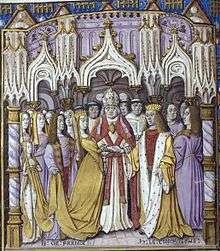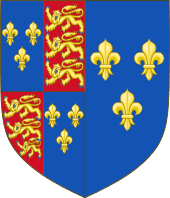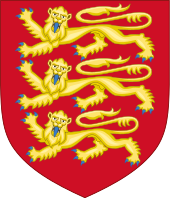Catherine of Valois
Catherine of Valois (27 October 1401 – 3 January 1437) was the queen consort of England from 1420 until 1422. A daughter of Charles VI of France, she married Henry V of England,[1] and gave birth to his heir Henry VI of England. Her liaison (and possible secret marriage) with Owen Tudor proved the springboard of that family's fortunes, eventually leading to their grandson's elevation as Henry VII of England.[2] Catherine's older sister Isabella was queen of England from 1396 until 1399, as the child bride of Richard II.
| Catherine of Valois | |
|---|---|
 Marriage of King Henry V of England and Catherine of Valois. Illumination, Jean Chartier, Chronicle of Charles VII, av. 1494, British Library, Royal E.V., f. 9v. | |
| Queen consort of England | |
| Tenure | 2 June 1420 – 31 August 1422 |
| Coronation | 23 February 1421 |
| Born | 27 October 1401 Paris, France |
| Died | 3 January 1437 (aged 35) London, England |
| Burial | Westminster Abbey, London |
| Spouse | |
| Issue among others | |
| House | Valois |
| Father | Charles VI of France |
| Mother | Isabella of Bavaria |
| Religion | Roman Catholicism |
Early life
Catherine of Valois was the youngest daughter of King Charles VI of France and his wife Isabeau of Bavaria.[3] She was born at the Hôtel Saint-Pol (a royal palace in Paris) on 27 October 1401. Early on, there had been a discussion of marrying her to the Prince of Wales, the son of Henry IV of England, but the king died before negotiations could begin. In 1414, the prince, now Henry V, re-opened discussion of the match, along with a large dowry and acknowledgement of his right to the throne of France.
While some authors have maintained that Catherine was neglected as a child by her mother, a more modern examination of the evidence suggests otherwise. According to the financial accounts of her mother, toys befitting a French princess were purchased, religious texts were provided, and Catherine was sent to the convent in Poissy to receive a religious education.[4]
Royal marriage
Henry V went to war with France, and even after the great English victory at Agincourt, plans for the marriage continued. Catherine was said to be very attractive and when Henry finally met her at Meulan, he became enamoured. In May 1420, a peace agreement was made between England and France, the Treaty of Troyes, and Charles acknowledged Henry of England as his heir. Catherine and Henry were married at the Parish Church of St John or at Troyes Cathedral on 2 June 1420. Catherine went to England with her new husband and was crowned queen in Westminster Abbey on 23 February 1421. In June 1421, Henry returned to France to continue his military campaigns.
By this time, Catherine was several months pregnant and gave birth to a son named Henry on 6 December 1421 at Windsor. Her husband never saw their child. During the siege of Meaux, he became sick and died on 31 August 1422, just before his 36th birthday.[5] Catherine was not quite 21 and was left a queen dowager. Charles VI died a couple of months after Henry V, making the young Henry VI king of England and English-occupied northern France. Catherine doted on her son during his early childhood.
Relationship with Owen Tudor
Catherine was still young and marriageable, a source of concern to her brother-in-law Humphrey, Duke of Gloucester, the guardian of her son. Rumours abounded that Catherine planned to marry Edmund Beaufort, Count of Mortain, her late husband's cousin. The Duke of Gloucester was strongly against the match, however, and the Parliament of 1427–8 passed a bill which set forth the provision that if the queen dowager remarried without the king's consent, her husband would forfeit his lands and possessions, although any children of the marriage would not suffer punishment. The king's consent was contingent upon his having attained his majority. At that time, the king was only six years old.
Catherine lived in the king's household, presumably so she could care for her young son, but the arrangement also enabled the councillors to watch over the queen dowager herself. Nevertheless, Catherine entered into a sexual relationship with Welshman Owen ap Maredudd ap Tudor, who, in 1421, in France, had been in the service of Henry V's steward Sir Walter Hungerford. Tudor was probably appointed keeper of Catherine's household or wardrobe. The relationship began when Catherine lived at Windsor Castle, and she became pregnant with their first child there. At some point, she stopped living in the King's household and in May 1432 Parliament granted Owen the rights of an Englishman. This was important because of Henry IV's laws limiting the rights of Welshmen.

There is no known date of Catherine's marriage to Owen,[6] and yet there is no contemporaneous evidence that the validity of the marriage and the legitimacy of her children were questioned in secular or canon law.[7] From the relationship of Owen Tudor and Queen Catherine descended the Tudor dynasty of England, starting with King Henry VII. Tudor historians asserted that Owen and Catherine had been married, for their lawful marriage would add respectability and stronger royal ties to the claims of the Tudor dynasty.
Owen and Catherine had at least six children. Edmund, Jasper and Owen were all born away from court. They had one daughter, Margaret, who became a nun and died young.
Death and aftermath
Catherine died on 3 January 1437, shortly after childbirth, in London, and was "buried in the old Lady chapel" of Westminster Abbey.[8] While the death date is not in question the cause is, with an equal number of records stating that she did not die as a result of childbirth, but entered Bermondsey Abbey, possibly seeking a cure for an illness that had troubled her for some time. She made her will just three days before her death. She now rests at Westminster Abbey in Henry V's Chantry Chapel. After her death, Catherine's enemies decided to proceed against Owen for violating the law of the remarriage of the queen dowager. Owen appeared before the council, was subsequently arrested, and taken to Newgate Prison.[9] He tried to escape from Newgate Prison in early 1438 and eventually ended up at Windsor Castle in July of that year.[9]
Meanwhile, Owen and Catherine's two older sons, Edmund and Jasper, went to live with Katherine de la Pole, Abbess of Barking and sister of William de la Pole, 1st Duke of Suffolk. Sometime after 1442, the king (their half-brother) took a role in their upbringing. Owen, their father, was eventually released on £2000 bail, but was pardoned in November 1439 (and the bail cancelled in 1440). Owen was treated well afterwards and was a member of the king's household until the mid-1450s. He lived until 1461, when he was executed by the Yorkists following the Battle of Mortimer's Cross in Herefordshire. Their sons were given earldoms by Catherine's son King Henry VI. Edmund married Margaret Beaufort, a descendant of John of Gaunt who had consequently a distant claim to the throne; following the elimination by war of most other candidates, their son became King Henry VII.
The wooden funeral effigy which was carried at Catherine's funeral still survives at Westminster Abbey, and was previously on display in the Westminster Abbey Museum in the Undercroft. It is now displayed in the new Queen's Diamond Jubilee Gallery in the abbey triforium. Her tomb originally boasted an alabaster memorial, which was deliberately destroyed during extensions to the abbey in the reign of her grandson, Henry VII. It has been suggested that Henry ordered her memorial to be removed to distance himself from his illegitimate ancestry. At this time, her coffin lid was accidentally raised, revealing her corpse, which for generations became a tourist attraction. In 1669 the diarist Samuel Pepys kissed the long-deceased queen on his birthday:
On Shrove Tuesday 1669, I to the Abbey went, and by favour did see the body of Queen Catherine of Valois, and had the upper part of the body in my hands, and I did kiss her mouth, reflecting upon it I did kiss a Queen: and this my birthday and I thirty-six years old and I did kiss a Queen.
— Samuel Pepys
Catherine's remains were not properly re-interred until the reign of Queen Victoria.
In historical fiction
- William Shakespeare's play Henry V depicts Catherine of Valois' marriage to Henry V of England after the Battle of Agincourt.
- Catherine of Valois is the subject of Rosemary Hawley Jarman's novel Crown in Candlelight (1978)
- Margaret Frazer's medieval mystery The Boy's Tale (1995) features Catherine and her sons Edmund and Jasper.
- In The Queen's Secret by Jean Plaidy, Catherine is the title character.
- Another novel by Jean Plaidy, Epitaph for Three Women, retells the minority of Henry VI by focusing on the lives of Catherine, Joan of Arc and Eleanor, Duchess of Gloucester.
- In the historical novel, Fortune Made His Sword by Martha Rofheart, Catherine is one of five narrators who tell the story of Henry V.
- Dedwydd Jones's novel, The Lily and the Dragon (2002) tells the story of Owain Tudor and Catherine of Valois.
- Joanna Hickson's novel The Agincourt Bride (2013) tells the story of the early life of Catherine of Valois while its sequel The Tudor Bride (2014) tells of her life as the Queen of England and her relationship with Owen Tudor.
- Anne O'Brien's novel The Forbidden Queen (2013) details the life of Catherine of Valois.
- Vanora Bennett's novel Blood Royal/The Queen's Lover (2009) tells the story of Catherine's early years through her secret marriage to Owen Tudor.
- Mari Griffith's novel Root of the Tudor Rose (2014) is the story of Catherine's brief marriage to Henry V and her subsequent clandestine relationship with Owain ap Maredydd ap Tudur.
- Rosemary Anne Sisson's play The Queen and the Welshman (1957) tells the story of Catherine de Valois and Owen
- In the Netflix film The King (2019), Catherine is played by Lily-Rose Depp.
References
- Haigh 2000, p. 345.
- Williams & Fraser 2000, p. 19.
- Fritze & Robison 1992, p. 94.
- Gibbon 1996, pp. 51–63.
- Allmand 1992, pp. 173–174.
- Griffiths & Thomas 2005, p. 35.
- Chrimes 1980, pp. 320–333.
- Harvey 2003, p. 27.
- Chrimes 1999, pp. 9–10.
Sources
- Allmand, Christopher (1992). Henry V. University of California Press.CS1 maint: ref=harv (link)
- Chrimes, S. B. (1980). "The Reign of Henry VI: Some Recent Contributions". Welsh History Review. 10 (1): 320–333. ISSN 0043-2431.CS1 maint: ref=harv (link)
- Chrimes, S.B (1999). Henry VII. Yale University Press.CS1 maint: ref=harv (link)
- Fritze, Ronald H.; Robison, William Baxter, eds. (1992). Historical Dictionary of Late Medieval England, 1272–1485. Greenwood Publishing Group.CS1 maint: ref=harv (link)
- Gibbon, Rachel (1996). "Isabeau of Bavaria, Queen of France (1385–1422): The Creation of an Historical Villainess: The Alexander Prize Essay". Transactions of the Royal Historical Society. 6: 51–63. doi:10.2307/3679229. JSTOR 3679229.CS1 maint: ref=harv (link)
- Griffiths, Ralph A.; Thomas, Roger S. (2005). The Making of the Tudor Dynasty. Sutton Publishing.CS1 maint: ref=harv (link)
- Haigh, Christopher, ed. (2000). The Cambridge Historical Encyclopedia of Great Britain and Ireland. Cambridge University Press.CS1 maint: ref=harv (link)
- Harvey, Barbara (2003). "The monks of Westminster and the old Lady chapel". In Tatton-Brown, Tim; Mortimer, Richard (eds.). Westminster Abbey: The Lady Chapel of Henry VII. The Boydell Press. p. 5-32.CS1 maint: ref=harv (link)
- Williams, Neville; Fraser, Antonia, eds. (2000). The Tudors. University of California Press.CS1 maint: ref=harv (link)
External links
| Wikimedia Commons has media related to Catherine of Valois. |
- . Encyclopædia Britannica. 5 (11th ed.). 1911.
- Heidi Murphy Catherine of Valois (1401–1437)
Catherine of Valois Cadet branch of the Capetian dynasty Born: 27 October 1401 Died: 3 January 1437 | ||
| English royalty | ||
|---|---|---|
| Vacant Title last held by Joanna of Navarre |
Queen consort of England Lady of Ireland 2 June 1420 – 31 August 1422 |
Vacant Title next held by Margaret of Anjou |
